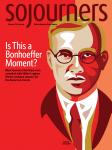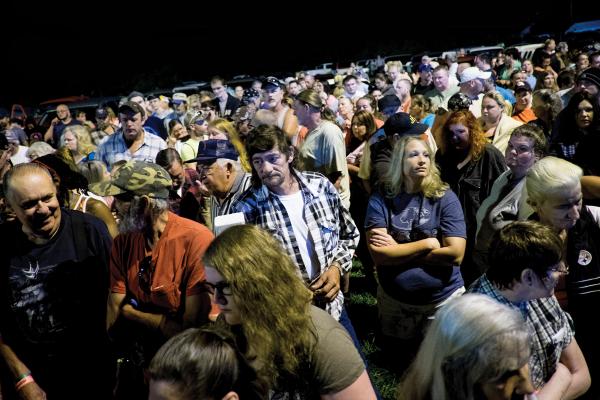This article appears in the February 2018 issue of Sojourners magazine. To subscribe, click here .
ACCESS TO HEALTH CARE IS CONTROVERSIAL. Many people in the United States enjoy access to excellent health care, but high premiums and pre-existing conditions have eliminated coverage for others. Some politicians (privileged with extensive health-care coverage) have even made determined efforts to deny health-care access to nearly 30 million people. Their actions are like the response of elite allies and agents of Roman power to Jesus in Matthew’s gospel, when Jesus healed people of various afflictions.
What’s true today under American empire was also true under the Roman Empire: Acts of healing have political as well as spiritual ramifications. The attention that Matthew’s gospel gives to Jesus’ healings might point us to some best practices for health care today.
In Matthew’s gospel, Jesus is always healing. The gospel alternates summaries of his general healing activity with details of specific healings.
Matthew 4 sets up the frame: “Jesus went throughout Galilee ... proclaiming the good news of the kingdom and curing every disease and every sickness among the people. So his fame spread throughout all Syria, and they brought to him all the sick, those who were afflicted with various diseases and pains, demoniacs, epileptics, and paralytics, and he cured them” (23-24).
This summary is touched on eight other times in Matthew, surrounded by 14 individual healing scenes: a leper (8:1-4), a paralyzed slave (8:5-13), Peter’s fevered mother-in-law (8:14), two demoniacs (8:28-34), a paralyzed man (9:2-8), a woman with a hemorrhage (9:20-22), a dead girl (9:23-26), two blind men (9:27-31), a deaf man who cannot speak (9:32-34), a man with a withered hand (12:9-14), a demoniac who cannot see or speak (12:22-24), a demon-possessed girl (15:21-28), a “moon-struck” demon-possessed boy (17:14-20), and two blind men (20:29-34).
What is the significance of these actions? What do they contribute to the gospel narrative of Jesus as the agent of God’s saving reign/empire?
Don’t over-spiritualize
Most explanations focus on Jesus—and thus risk decentering those who suffer and are healed. Some claim that the healings show Jesus to be divine, but the ability to heal does not make a person divine. Disciples are commissioned to heal and they are not constructed as divine (10:7-8). There were other healers in the Roman world about whom claims of divinity were not made.
Another interpretation is that healings show Jesus to be the Messiah/Christ. But this explanation is not convincing either. Among those who were looking for the Messiah, there wasn’t a checklist of signs by which the Messiah could be identified. Healings do not equate with Messianic identity. Nor does the commissioning of disciples to heal and exorcize make them messiahs, just as it does not make other healers in the Roman world messiahs.
Another unsatisfactory but common approach is to spiritualize the healings. In part, Matthew’s gospel encourages this approach. It employs both deafness and blindness as metaphors for those who do not perceive God’s reign/empire to be manifested in Jesus’ activity (13:14-15). Many interpreters then read the healing scenes in the same metaphorical manner to claim them as moments of “insight” or comprehension. But there is no reason to subordinate all the summary and individual scenes of healing to these verses and read them as metaphors for gaining understanding. Jesus does not demand understanding before he heals; nor often does he require faith.
Unacceptable in these three interpretations is the indignity of turning the suffering and healed into visual aids that serve either Christological purposes in attesting Jesus’ identity or discipleship/ecclesial purposes in highlighting faith, understanding, and obedience.
In those approaches, doctrinal or religious issues replace people and divert attention from the somatic and material transformations effected in their lives. Admittedly, the gospel encourages this erasure since the scenes often ignore the circumstances of suffering folks. But resisting readers can pause to imagine the “before-and-after” scenarios of transformed lives.
So how might we understand these healing scenes? Why are there so many sick folks in the gospel narrative? The answers emerge from focusing on the structures and systems of the Roman Empire. Much interpretation ignores this imperial context and pretends that the “religious” gospel text does not engage its sociopolitical, imperial world.
But the gospel, peopled with sick folks, mirrors the imperial world.
Empire sickens
The Roman world was hierarchical with vast societal inequalities, economic exploitation, and political oppression. The hierarchy comprised several layers of ruling elites with varying degrees of wealth, power, and status (perhaps 2 to 4 percent of the population) presided over by the emperor and very wealthy senators. A middling group with some resources enjoyed a comfortable way of life (perhaps 7 to 17 percent).
Three layers of the poor spanned those living near subsistence levels to those living below subsistence. These comprised some 80 to 90 percent of society. That is, most people lived with little power, wealth, or status—in varying degrees of poverty—seasonally cycling around, above, and below subsistence levels.
These folks, whether urban or rural dwellers, were vulnerable to numerous forces that could severely impact their livelihoods: work availability, variable harvest yields, high prices, profiteering, war, irregular food and water supply, low wages, unsanitary and crowded living conditions, housing costs, taxes, rents, natural disasters, and so forth.
In this imperial system, control of and access to good quantities of nutritionally adequate food reflected societal power and inequities. Food was a sign of elite, conspicuous consumption and power. Food insecurity, the norm for many, reflected a lack of power, wealth, and status, as well as the considerable vulnerability of many non-elites.
In theory, the Mediterranean diet—comprising mostly grains, beans, olives, and vine products—was reasonably healthy. But in practice, a lack of variety, poor nutritional quality, and variable supplies impacted by harvests, weather, poor transport and storage, seasonal variations, and limited purchasing power frequently resulted in diets of inadequate nutrition.
A consequence of inadequate nutrition is disease. Poor nutrition results in lowered immunity and renders people more vulnerable to infectious diseases such as diarrhea, dysentery, cholera, typhus, meningitis, and scarlet fever.
Along with diseases of infection were diseases of deficiency. Classicist Peter Garnsey links Vitamin A deficiency, for example, with blindness, bone deformation, growth retardation, and lowered immunity. Vitamin C deficiency retards development of bones and teeth, as well as contributes to scurvy. Vitamin D deficiency causes muscle weakness and limits bone growth. Garnsey observes that “for most people, life was a perpetual struggle for survival.”
In addition, congenital defects, injuries from accidents, poor hygiene systems, and a lack of knowledge about hygiene and medical care contributed to sick and disabled bodies.
Moreover, daily life was very stressful. Stress takes its toll on relationships and bodies, including decreased immunity. Studies have also linked psychosomatic illness and demon possession with imperial and oppressive contexts. Symptoms such as muteness and paralysis can indicate people overwhelmed by power, by the trauma of domination. They can also be coping mechanisms of disengagement and distancing or self-protective protests through inactivity and non-compliance.
A sure sign of the lethal quality of life in Rome’s empire was a short average life expectancy of around 20 to 25 years. For those who made it to age 10, there were perhaps another 35 years. Death rates were high. By one estimate, half of the infants who survived birth did not see their fifth birthday. Imperial power is bad for health.
It is not surprising, then, that Matthew’s gospel is peopled with sick folks.
God’s empire heals
The presence of so many sick people attests to the destructive impact of Roman power. Jesus’ healings repair damage inflicted by imperial structures and systems. They rolled back negative effects of imperial hierarchies and systems that privileged powerful elites. Jesus’ compassionate (Matthew 9:36) and merciful power (9:13, 12:7) confronts destructive imperial power. His healings expose the lie of imperial propaganda.
Numerous imperial sources claim that the Roman Empire was making the world healthy again. Augustus had, so it was said, launched a “golden age” marked by health and abundant fertility. But 100 years later, when Matthew’s gospel was written, the “golden age” had still not dawned.
The gospel interprets Jesus’ healing actions as manifestations and anticipations of God’s new world, marked by God’s life-giving purposes.
In Matthew 11:2-6, Jesus tells John’s disciples, “Go tell John what you hear and see: The blind receive their sight, the lame walk.” Jesus explains his actions by referring to verses from the prophet Isaiah (26:19, 29:18-19, and 35:5-6).
These passages envision the establishment of God’s reign/empire that creates a world marked by bodily health and wholeness. Other passages, such as Isaiah 25:6-10, anticipate that this coming world will feature abundant food and the end of death, tears, and disgrace.
Matthew’s gospel aligns with other Jewish texts that envision a new age under God’s reign/empire that transforms the inequities of Rome’s world to establish an age of “abundance and healing” (2 Esdras 7:123). For example, “Health will descend in dew, and illness will vanish, and fear and tribulation and lamentation will pass away” (2 Baruch 73:2).
By citing Isaiah’s vision, Matthew’s Jesus indicates that his healings begin to manifest this new world in which God’s reign/empire prevails.
Jesus’ healings display God’s reign/empire in the midst of Rome’s empire. They contest the imperial status quo even as the language of God’s reign/empire and its worldwide impact imitate imperial ways (Matthew 4:17, 12:28). His healings are signs or displays that embody God’s transforming reign/empire in the present moment. They do not manifest the fullness of God’s reign/empire yet, but anticipate this coming future.
What matters?
None of this provides a blueprint for sickness and healing in our contemporary setting. But it does suggest some implications for embodying the divine reign/empire in our present day.
One is the strong affirmation that healthy bodies matter. The gospel narrates the compassionate and merciful repair of some bodies to effect somatic well-being and wholeness.
A second implication recognizes psychosomatic and societal connections. Unjust and oppressive imperial structures, practices, and conditions impact the physical and mental well-being of their inhabitants. Sickness and healings are contextualized in larger societal visions. Attention to—and reform of—destructive societal structures matters.
Third is the issue of accessibility. The healing scenes in Matthew bring to the foreground folks who occupied social margins. Sick and disabled folks were at times mocked and not as valued as able-bodied folks who could contribute to households through work. Yet Jesus is accessible to heal anyone. Unlike other sources of healing, such as doctors or cultic sites or shrines (for example, those of Asclepius or Isis), Jesus’ healings did not require the sick and caregivers to undertake lengthy and expensive travel to a sacred site. No one pays Jesus a premium for healing.
Fourth, this healing task is entrusted to—and continues through—Jesus’ disciples (10:7-8).
The healings in Matthew’s gospel were somatic, material, physical, and societal. By employing a “now and not yet” perspective, the gospel does not guarantee universal healing; nor does it render healing a normative expectation for the present. However, our present times do offer much unfinished, divine work, for the healing of bodies and nations.

Got something to say about what you're reading? We value your feedback!

